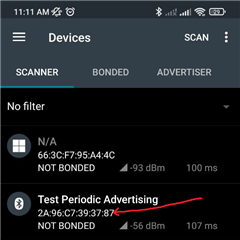Hi
I am using Zephyr samples (common with the samples found in NCS) to evaluate the advertisement function of nRF52833DK.
I have run these examples:
- Bluetooth: Periodic Advertising: https://docs.zephyrproject.org/latest/samples/bluetooth/periodic_adv/README.html
- Bluetooth: Direction Finding Periodic Advertising Beacon: https://docs.zephyrproject.org/latest/samples/bluetooth/direction_finding_connectionless_tx/README.html
In both cases, the device's id changes after the reboot (checked by nRF Connect):

Also I tried to change the id before enabling the BLE as described in this devzone ticket, but it didn't work.
Now my questions are:
1- Why after reboot a random address is assigned to the device and it doesn't use the address was assigned to the device at manufacturing time?
2- How can I change the address that is used for advertising?
Regards,
Saleh
